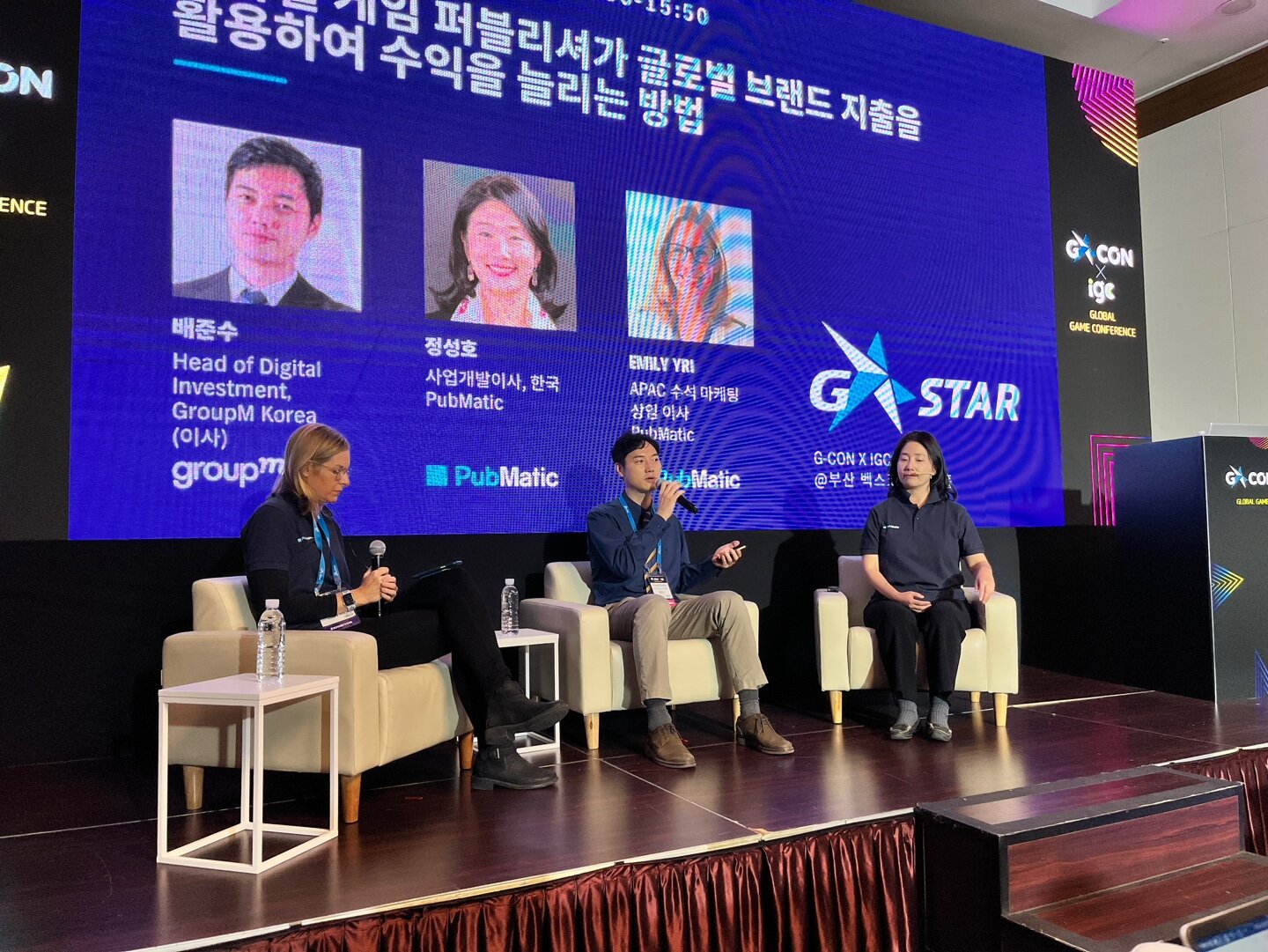topic : How mobile game developers can access global brand spend and improve profitability Speaker: Jung Sung Ho – Pubmatic / Business Development Director Field : mobile, marketing Now : 18.11.2022 (Fri) 15:00 ~ 15:50 summary : Pubmatic’s director of business development, Jeong Seong-ho, presented how mobile developers can make money from brand advertising. In addition, Emily Yri, Senior Marketing Director of APAC, held a roundtable discussion with Business Development Director Jeong Seong-ho and Group M Korea Director Bae Jun-soo, and told various stories.
■ Importance of brand advertising – Is there an ad that can make money just by watching it?
Pubmatic’s director of business development, Jeong Seong-ho, stressed the importance of brand advertising during the conference preceding the panel discussion. He explained that many large companies are already transitioning from traditional TV ads to digital ones, focusing on branded advertising.
This advertising model, like any other advertising, starts with the advertiser. It is common to outsource the advertising execution budget to a large advertising agency. This is where you decide on your campaign plan and budget, and use the programmatic trading desk to run your campaign through your preferred delivery partner. In this process, capital moves to the SSP. SSPs hold auctions and this capital flows to mobile publishers.
Brand advertising is important for three reasons. First, publishers earn money simply by displaying branded ads in their apps. This has the effect of keeping users already protected in the game or app longer. Furthermore, since the quality of the ad itself is on average high because it consists only of selected ads, it is possible to create a cutting effect on the user experience. Finally, the above effects also maintain the stability of the brand.
In addition, director Jeong Seong-ho has introduced ways for mobile publishers to ensure brand spending. The first thing I heard was OMSDK compliance. OMSDK is designed by iab to facilitate third-party visibility and validation measurement of ads delivered to web video and native app experiences. He also explained about avoiding harmful ads, maintaining high ad quality, and adopting different ad formats.
He went on to talk about alternative methods to overcome the recent global economic crisis. Director Jung emphasized the use of private markets, stating that it is important to implement various models and open markets. Furthermore, he said that the preference for programmatic methods over existing advertising methods should be increased.
■ Round table of 3 people – Focusing on director Junsu Bae’s answer

After the explanation of the director of business development Jung Sung-ho, a three-person panel discussion was held with the participation of Emily Yri and director Bae Jun-soo. The following is an excerpt of Director Bae Jun-soo’s remarks during the three-person roundtable discussion.
As you explained earlier, inventory is purchased not only through the open market but also through the private market. Among them, the method we prefer is the private side. When buying from the open side, it is very difficult to control the supply chain. So there can be various risks to the brand and there is also a price aspect.
We make direct purchases by collaborating selectively with trusted supply chains. If so, we are adopting this method because it can reduce brand risk and increase pricing efficiency.
Since we have big challenges to overcome, I think we need to talk about heartbreaking but realistic things and move forward. As many of you in the industry have heard, there is still a lot of misconceptions around game inventory in advertising. Most of them care a lot about brand risk.
I think a little differently. Indeed, there is a risk that very provocative advertisements such as adult content or violence could be published not only on TV but also on social media platforms such as YouTube and Meta. However, advertisers aren’t afraid of TV, YouTube or meta ads. Because you believe you can control it.
I think the same goes for games. Many game titles are something people of all ages can enjoy. If there is any risk factor in the game, it can also be sufficiently technically and selectively advertised by the brand.
We now prefer private markets. In fact, several years ago, we built a private market with global game publishers and created premium inventory.
Speaking of premium inventory, you might think it’s for luxury brands, but it’s applicable to all categories of advertisers. Because advertisers consider it very clean, safe and reliable.
As you may have noticed, luxury brands have been investing heavily in gaming lately. For example, Gucci has been investing in game inventory advertising for a long time and recently made and sold products that are only sold in the metaverse. And in the case of Louis Vuitton, it is showing a variety of appearances, such as announcing a prestige leather in the 2019 World Championship Finals.
In fact, approximately 40% of Group M Korea’s spending goes to luxury clients and they aim to expand from the current 40-50 female clients to the younger generation. And then I realized that these people spend most of their time in the game.
In my view, luxury customers will continue to invest in accessing game inventory. The challenge appears to be how can we deliver game inventory in a secure environment without harming their brand image.
Looking at it from a buyer’s perspective, I wish game publishers would actively invest. In fact, there was a limitation that made it difficult to go consistently. Ultimately, we had to keep growing our position, but there was an unfortunate situation where we couldn’t get the right position because we didn’t have the right inventory to buy in Korea.
Another thing I would like to ask is that I would really appreciate it if you partnered with third party verification agencies, such as the OMSDK mentioned earlier, so that buyers can buy with confidence, rather than just distributing ads.

